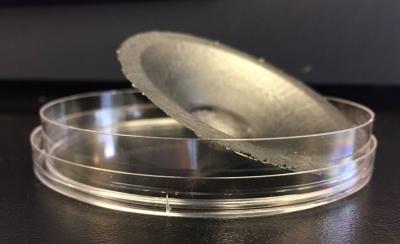ORA, a Canada-based early-stage start-up that develops graphene-enhanced audio equipment, has unveiled its graphene oxide-based composite material, dubbed grapheneQ. The material was thus named because of its low density and high stiffness, that reportedly allow for louder drivers that have a lower Q resonance, and has been specially designed for use in acoustic transducers.

Loudspeakers work by vibrating a thin diaphragm. These vibrations then create pressure waves in surrounding air that produce different sounds depending on their frequency. The membrane in any speaker can be thought of as a simple harmonic oscillator with an intrinsic mass and restoring force. The heavier the membrane’s mass, the more inertia and sharper resonance it has because of its high Q. The most common way to reduce resonance and broaden bandwidth is to add damping, but this ultimately reduces the efficiency of the driver.
The ORA team explains that it has made its graphene oxide by reducing graphene and then adding a proprietary blend of cross linkers to make the composite. The lower Q resonance of the material means that it requires less damping (especially at low frequencies) than commercial devices to prevent unwanted frequency responses. This means that the device uses much less power than conventional speakers a real advantage if it were to be employed in portable devices. Less damping at lower frequencies also means that the bass and treble response are both extended, which drastically improves the fidelity of the music being reproduced.
The GrapheneQ material is also said to be very stiff and distorts very little thanks to its high Young’s Modulus of up to 130 GPa. This allows sound waves to travel very quickly through the material, producing a better overall quality of sound. The material has a very high thermal conductivity too, which makes it less likely to be damaged from overheating a common cause of speaker damage.
"GrapheneQ membranes have both a low density (they are very thin) and a high Young’s Modulus, as mentioned, and so offer an ideal balance of strength, density and damping, explains company co-founder and business lead. The company adds that this approach not only improves sound quality but is also simple, economical, and works as a drop in replacement with most current loudspeakers.
The ORA researchers, who will be showing a prototype of their speaker to the public for the first time at CES in Las Vegas in January 2017, hope that GrapheneQ will become a standard material for loudspeaker membranes in the future. The company also mentioned that it has been negotiating evaluation agreements with some of the largest consumer audio and cellphone manufacturers. No names were given due to secrecy issues, so time will tell where we will be seeing these materials.
Graphene membranes based speakers have been under development a while. Graphene can enable very thin membranes and these speakers prove to be highly accurate - in addition to being more efficient (as less energy is required to move the membrane). The first research in this area was presented in 2011 when researchers from Seoul's National University developed a transparent and lightweight speaker made from Graphene.
In 2013 researchers demonstrated that a graphene-based speaker can outperform even the best commercially-available earphones. Another interesting research was published in September 2016, when researchers at Korea Advanced Institute of Science and Technology (KAIST) developed a new graphene-oxide based thermoacoustic speaker that does not require an acoustic box to produce sound - thermoacoustics is based on the idea that sound can be produced by the rapid heating and cooling of a material instead of through vibrations.
In November 2016 it was reported that Xiaomi's latest Piston 3 Pro earphones make use of a graphene membrane. This is not confirmed by Xiaomi's yet. In that same month, Israeli audio pioneer Waves Audio announced that it is going to develop an innovative electrostatic speaker using a nanoscale active membrane based on graphene in collaboration with the Virginia Polytechnic Institute and State University.